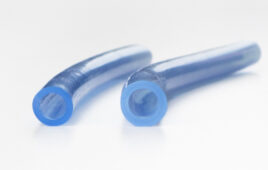
The headset of Wicab’s Brainport V100 includes polycarbonate, end-use parts from Proto Labs. [Image courtesy of Wicab]
The BrainPort V100 received FDA de novo marketing approval last year for use among the profoundly blind. It uses a small headset-mounted video camera to capture visual information. The user feels the information as tingling or vibrations on a small mouthpiece embedded with electrodes and placed on the tongue. By taking three, three-hour training sessions mandated by FDA, users learn to substitute the sense of touch on their tongues for some of their lost sight. BrainPort helps them recover abilities such as being able to walk to a store or dine at a restaurant.
The late University of Wisconsin neuroscientist Paul Bach-y-Rita developed the technology, founding Wicab in 1998. Wicab initially sought to use the technology to help people with balance issues but switched to developing a device for the blind in 2005. The company has raised $26 million over the years. In 2012, Wicab received a $3.2 million Defense Department grant, topped by $2.5 million from Google.
Receiving FDA’s de novo blessing meant that Wicab faced a challenge that medical device companies often encounter when marketing ramps up: The company had to switch manufacturing processes to increase production in an effective and efficient manner. Proto Labs (Maple Plain, Minn.) was able to deliver on manufacturing innovation to support Wicab’s medtech innovation.
“Time to market and cost of goods sold can make or break product launches. Proto Labs is enabling a potential breakthrough product to get to people in need,” said Frank Jaskulke, vice president of member services at the Minnesota-based Medical Alley Association, when told about the story.
Solving the manufacturing challenge
Wicab had used 3D printing for prototyping the BrainPort V100, as well as the next-generation BrainPort Vision Pro that still needs FDA approval. The 3D printing processes including fused deposition molding (FDM), stereolithography (SL), and selective laser sintering (SLS) didn’t pass muster for Wicab’s new needs.
“The FDM process would allow us to use polycarbonate but it doesn’t have the resolution required for [field testing] parts. [SL and SLS] have the resolution capability, but the material selection is limited, so it’s tougher to make parts that can be placed in the field for long periods of time,” Rich Hogle, Wicab’s vice president and research and development director, explained in a recent Proto Labs news release.
Wicab instead sought to manufacture headset parts through cast urethane. “And that’s where it started to get expensive to make parts because you have to make molds every time. You can only get so many parts out of a mold in cast urethane,” Hogle said
Proto Labs focuses on highly automated quick-turn processes. It grabbed Hogle’s attention because even though it didn’t offer urethane casting, its pricing and turnaround time was favorable.
“In the past, if we wanted injection-molded parts, the tooling alone was so expensive that it sort of ruled it out for prototyping. But now with Proto Labs, we were able to find there was a reasonable tradeoff between having near-production-quality parts in conjunction with quick-turn capability, and that’s what really got us excited about working with Proto Labs,” Hogle said.
Besides the favorable pricing and time, Proto Labs was able to work with Wicab on minor design tweaks to improve results with Proto Labs’s tooling design process. For example, the headset had to be kept small and comfortable for the user even though the electronics fit into a tight space inside.
“Once that was complete, they were able to make the tools and shoot the parts in under 15 business days,” Hogle said. “That was fantastic.”
Proto Labs experts also helped Hogle and others at Wicab settle on polycarbonate as a material because of its quality finish and feel, and its ability to meet medical device material requirements.
“Since these are true injection-molded parts, they’re going to last much longer than cast urethane or 3D printed parts would last in the field,” Hogle said. “The durability and material finish, those are the kinds of attributes that are important when you’re moving things from the lab out into real users’ hands.”
The result was that Proto Labs injection molding processes are now creating polycarbonate, end-use parts for both the BrainPort V100 and the BrainPort Vision Pro.
Said Hogle: “We like the fact that at any point we can order additional parts and we know what the cost is going to be, what the quality is going to be, and the delivery time.”
[Want to stay more on top of MDO content? Subscribe to our weekly e-newsletter.]




